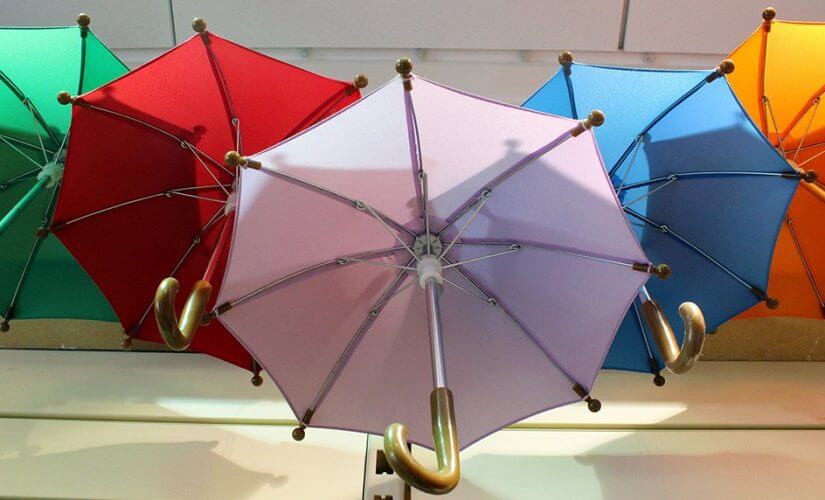Everyone needs an umbrella! Whether you’re searching for a basic, collapsible rain umbrella or an umbrella with artistic flair, read on to make an educated purchase.
Not all umbrellas are good umbrellas, in fact, not all umbrellas on the market are even water-resistant! And so trying to find the right rainproof companion to shield you when the weather gets a little rocky can be a little puzzling, and there are so many different types of umbrellas out there to choose from! The trick, really, is matching the umbrella to your needs, so we’ve put together a guide to help you find the ideal one.
Finding the Right Size…
The starting point with any umbrella buying quest is usually size, and there are a lot of factors to take into account when sizing up your new umbrella.
Golf Umbrellas
The bigger the canopy, the more shelter from the rain your umbrella can potentially offer. Large golf size umbrellas are often very sturdy, many of them are even able to withstand high wind speeds without giving up at the crucial moment.
But while there are definite advantages to carrying around a huge golf umbrella, it may not always be the most practical option. Trying to navigate around the often busy, and sometimes narrow streets, with your own portable roof over your head could be really rather tricky, and getting snagged on other passing umbrellas seems all the more likely. The very large golf umbrellas also tend to have a long handle shaft, which can make them somewhat cumbersome to drag around with you all day, and so are perhaps better suited for rainy jaunts into more open areas. If you’re often on foot in urban areas then a smaller and more easily portable option may suit your needs better.
Walking Umbrellas
A walking umbrella is a popular option, as these full-length umbrellas offer a sizeable canopy for coverage, and are a bit more practical to carry around than a golf umbrella. It’s also worth noting that the fewer moving parts an umbrella has then the stronger it probably is, and the longer its life expectancy. Walking umbrellas then, are a good investment, as they have few folding parts that can break, and the handle shaft is generally very sturdy since it’s one continuous piece. They also look great, and are a smart solution to staying dry.
The walking umbrella, however, can’t fit inside a bag for easy storage, and may not be the lightest option for carrying with you all day—especially if you only need an umbrella just in case it does rain.
Folding Umbrellas
This common problem is, of course, where the folding umbrella comes in handy, and these come in a range of sizes and weights. While most folding umbrellas don’t offer a huge amount of coverage (and there are some exceptions), they do usually give enough to keep you dry if you get caught unexpectedly out in the rain, and they’re fantastic for storing in your bag, which means you can always have your umbrella to hand when you need it most. It’s worth bearing in mind, though, that because they can fold up conveniently small, folding umbrellas do tend to be that little bit more vulnerable to wind damage than some of their larger counterparts.
Some Things to Think About…
Aside from the physical size of the umbrella, there are other factors that are worth thinking about in order to find an umbrella that suits your needs.
Automatic vs. Manual?
If you’re constantly finding yourself struggling to put your umbrella up while you get drenched then you might want to consider an automatic umbrella. These work so that your umbrella will spring open at the touch of a button, saving you the struggle and keeping you dry that little bit quicker. An automatic umbrella can be a great idea if you’re prone to catching your fingers in the mechanism, or generally, if you’re popping in and out of the rain and want an easier, quicker way of putting your umbrella up and down.
But of course, as with any feature, there are also certain drawbacks to an automatic umbrella. Because the automatic function relies on a mechanism and a button it slightly increases the number of possible ways in which the umbrella might break, which can reduce its lifespan. The automatic mechanism may also mean the umbrella weighs a little more (although light ones are also available), which is especially worth thinking about if you’re looking for something convenient to pop in a bag and carry everywhere.
What’s It Made From?
Not all umbrellas are made out of the same stuff and believe us, the materials used can have a big impact on the strength and weight of your umbrella. A fibreglass frame, for example, will be very strong, and often non-conductive (ideal for storms). Aluminium, while not quite as strong as fibreglass, is nice and light, and so great for storing in your bag. Some smaller umbrellas use a combination of the two, so you get the best of both.
Is It Easy to Hold?
The last thing you want is an umbrella that’s uncomfortable to hold in the wind and the rain, so we can’t stress enough the importance of picking an umbrella with a handle that’s comfortable and easy to hold. This largely comes down to preference, and factors such as the size of your hands. It’s often really a case of trying out different ones to see what feels comfortable—and bear in mind that you might need to be able to hold it in either hand.
If a walking umbrella or a golf umbrella is your preference then bear in mind the length of the umbrella when folded relative to your own height. If the umbrella is too long for you to comfortably carry, then it probably isn’t a good choice.
How Strong is It?
If you’re looking for something sturdy then we recommend taking a peek under the canopy, as not all umbrellas are held up in the same way. The rule of thumb generally is: the more spokes from the handle shaft holding things up the better supported the canopy is likely to be (and better suited it is to enduring weather). For a small umbrella, 6 spokes are fairly standard, but with larger umbrellas, we recommend something with 8 or more spokes supporting the canopy against the weather.
Check, also, if the spokes themselves have other supports coming off them, as this can mean the difference between keeping dry or ending up wet, with an umbrella in the bin… Some umbrellas come with a little added reinforcement, such as polycarbonate joints that give it extra strength.
It’s worth bearing in mind that no umbrella is completely wind-proof (every umbrella has its limits, and this will vary), but many do offer wind-resistant features, such as a wind vent or the ability to turn inside out with the wind rather than immediately breaking as soon as a slight breeze comes along. We suggest finding out what kind of wind resistance your umbrella offers before you buy.
Do You Like The Design?
An umbrella with a colourful design can help brighten up those rainy spells while allowing you to add your own personal touch to staying dry. Black remains a popular option, but there are umbrellas of all colours and patterns available on the market, as well as transparent ones.




